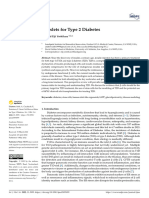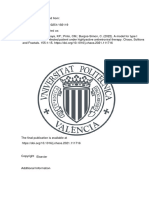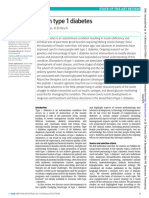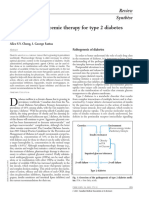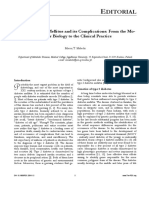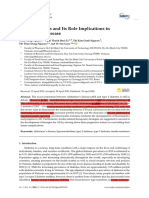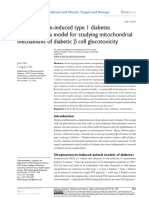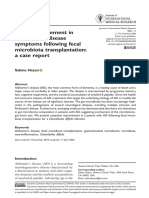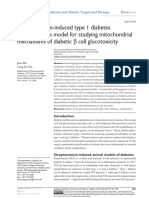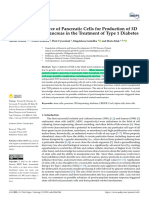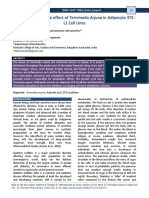6 175739 Diabetes
6 175739 Diabetes
Uploaded by
Nancy OcaCopyright:
Available Formats
6 175739 Diabetes
6 175739 Diabetes
Uploaded by
Nancy OcaOriginal Title
Copyright
Available Formats
Share this document
Did you find this document useful?
Is this content inappropriate?
Copyright:
Available Formats
6 175739 Diabetes
6 175739 Diabetes
Uploaded by
Nancy OcaCopyright:
Available Formats
Nancy Reyes Montes de Oca Friday 21st October 2022
Summary THE ULTIMATE CURE FOR
In Mexico, type 2 diabetes is one of
the main causes of blindness,
DIABETES
chronic renal failure and non-
traumatic amputations, and is one
of the 10 most frequent causes of
hospitalization in adults. In
MELLITUS
addition, it increases the risk of
suffering a myocardial or cerebral
infarction, and explains 30% of
general mortality.
TYPE 2
Based on data from the
aforementioned national surveys;
estimated that, by 2030, the
prevalence of type 2 diabetes
mellitus would reach 12 to 18%, and Source: https://www.practo.com/
by 2050, from 14 to 22%.
A NEW DRUG REVOLUTION
Introduction
Methods
Over time, the type of Conclusion and future prospects
pharmacological treatment for Mechanisms involving autoimmune
people living with diabetes has destruction of pancreatic beta-cells
changed; exclusive treatment with and peripheral tissue resistance to The innovation of this new drug turns
oral hypoglycemic agents, the use insulin have been suggested to cause out to be a hopeful and viable tool
of insulin, the use of glycosylated diabetes mellitus. towards the cure of type 2 diabetes
hemoglobin to monitor the control mellitus, although it still has to
of the disease, however, not all With molecular bases and gene advance in the research stages and
patients do not follow their therapy, it is possible to develop a must continue with an arduous path
treatment to such an extent that drug with a mechanism of action that of applications in animal models in
they permanently abandon it due can regenerate pancreatic beta-cells order to confirm its efficacy long
to the constant consumption of at a speed that only a single dose is term, and to be able to be used in the
drugs that interferes with the daily enough to obtain a favorable clinic with accessibility for all people.
activities of these patients. response to treatment.
The research and development of In addition, the advances reflect that,
an alternative treatment becomes In such a way that this form of cell in the future, apart from achieving a
potentially interesting and replacement is no longer destroyed cure for the disease through
necessary, or, much more by the patient's own immune system biotechnology, restoring absent
attractive, of a procedure that and does not involve complications, insulin levels, it would also be possible
makes it possible to cure the such as those caused by the use of to allocate similar drugs for the
disease, without patients immunosuppressants in the case of prevention of this condition, indirectly
presenting complications at the pancreas and pancreatic islet managing to counteract the various
vascular level in the event that the transplants. secondary complications. that
control of the blood glucose is patients with diabetes mellitus
insufficient. Basically, the cells of the present.
Studies on gene therapy have extrapancreatic tissues will be able to
begun with the aim of being able to “biologically design” themselves to
express insulin. These include liver
use it for the treatment of diabetes
tissue, bone marrow, and circulating
References
mellitus, however, they are only
limited to achieving an monocytes. Supported by multiple
Boada, C. C., & Martinez-Moreno, J. M. (2013).
autoimmune response by studies that the liver shares an
Pathophysiology of diabetes mellitus type 2:
preventing the destruction of these embryonic endodermal origin with beyond the duo “insulin resistance-
cells. Therefore, I believe that the pancreas, it is shown that the cells secretion deficit”. Nutricion hospitalaria,
something more innovative could can be manipulated to induce the co- 28(2), 78-87.
expression of insulin and glucagon. DeFronzo, R. A., Ferrannini, E., Groop, L.,
be invented that truly eradicates
Henry, R. R., Herman, W. H., Holst, J. J., ... &
the disease. Weiss, R. (2015). Type 2 diabetes mellitus.
Nature reviews Disease primers, 1(1), 1-22.
Ginter, E., & Simko, V. (2013). Type 2 diabetes
mellitus, pandemic in 21st century.
Diabetes, 42-50.
Denova-Gutiérrez, E., Muñoz-Aguirre, P.,
Shivappa, N., Hébert, J. R., Tolentino-Mayo,
L., Batis, C., & Barquera, S. (2018). Dietary
inflammatory index and type 2 diabetes
mellitus in adults: the diabetes mellitus
survey of Mexico City. Nutrients, 10(4), 385.
Source: https://www.commonwealthfund.org/ Source: https://www.tipacilar.com/diabetes-mellitus/
You might also like
- Tieuduongloai 2Document16 pagesTieuduongloai 220128139No ratings yet
- NatureDocument19 pagesNaturecevirmeberfinNo ratings yet
- Seminar: Epidemiology and Global Trends in Type 2 DiabetesDocument18 pagesSeminar: Epidemiology and Global Trends in Type 2 DiabetesRoopaNo ratings yet
- 1 s2.0 S0753332222005236 MainDocument14 pages1 s2.0 S0753332222005236 MainSiti zaharaNo ratings yet
- Development and Validation of Five UV Spectrophotometric Methods For Simultaneous Estimation of Ramipril and Amlodipine Besylate in CapsulesDocument10 pagesDevelopment and Validation of Five UV Spectrophotometric Methods For Simultaneous Estimation of Ramipril and Amlodipine Besylate in CapsulesIJPS : A Pharmaceutical JournalNo ratings yet
- Understanding The Cause of Type 2 DiabetesDocument10 pagesUnderstanding The Cause of Type 2 DiabeteslejemsukarNo ratings yet
- Chronic Low-Grade Systemic Inflammatory State and Insulin Resistance: Implications for Metabolic HealthDocument14 pagesChronic Low-Grade Systemic Inflammatory State and Insulin Resistance: Implications for Metabolic HealthInternational Journal of Innovative Science and Research TechnologyNo ratings yet
- Type 2 Diabetes The Lancet 2022Document18 pagesType 2 Diabetes The Lancet 2022Valentina Kerguelen HernándezNo ratings yet
- Emerging Targets in Type 2 Diabetes and Diabetic ComplicationsDocument23 pagesEmerging Targets in Type 2 Diabetes and Diabetic ComplicationsEmilio AldreteNo ratings yet
- Ijms 23 05099Document19 pagesIjms 23 05099hokano4953No ratings yet
- Diabetes Mellitus Tipo 1 LancetDocument14 pagesDiabetes Mellitus Tipo 1 LancetLina RojasNo ratings yet
- Deleterious Dozen DMT2Document18 pagesDeleterious Dozen DMT2cecilia zavala100% (1)
- Seminar: DiagnosisDocument14 pagesSeminar: DiagnosisyenyenNo ratings yet
- Understanding Insulin in The Age of Precision Medicine and Big Data - Under-Explored Nature of GenomicsDocument38 pagesUnderstanding Insulin in The Age of Precision Medicine and Big Data - Under-Explored Nature of GenomicsGestne AureNo ratings yet
- 2018 A Global Overview of Precision Medicine in Type 2 DiabetesDocument12 pages2018 A Global Overview of Precision Medicine in Type 2 Diabetesguanyulin01No ratings yet
- Diabetes and PeriodontitisDocument10 pagesDiabetes and PeriodontitisRobins DhakalNo ratings yet
- 01.A Model For Type I Diabetes in An HIV-infected Patient Under Highlyactive Antir...Document16 pages01.A Model For Type I Diabetes in An HIV-infected Patient Under Highlyactive Antir...AidNo ratings yet
- In-Vitro Cell Line Models and Assay Methods To Study The Anti-DiabeticDocument1 pageIn-Vitro Cell Line Models and Assay Methods To Study The Anti-DiabeticThasa Muthia WulandariNo ratings yet
- Diabetes Mellitus and Multiple TherapeutDocument9 pagesDiabetes Mellitus and Multiple TherapeutMOHAMMAD OVAISNo ratings yet
- DM Tipo1Document15 pagesDM Tipo1SixtoIñaguazoNo ratings yet
- Hope Paper 4 Part ADocument2 pagesHope Paper 4 Part AJeffrey MwendwaNo ratings yet
- Use of The Estimated Glucose Disposal Rate As A Measure of Insulin Resistance in An Urban Multiethnic Population With Type 1 DiabetesDocument6 pagesUse of The Estimated Glucose Disposal Rate As A Measure of Insulin Resistance in An Urban Multiethnic Population With Type 1 Diabetesjulio perezNo ratings yet
- Knowledge Gap in DiabetesDocument3 pagesKnowledge Gap in Diabetesamit545No ratings yet
- BMJ 2023 075681.fullDocument19 pagesBMJ 2023 075681.fullMd YousufNo ratings yet
- DiabetesDocument28 pagesDiabetesfebby.kamila.fahimaNo ratings yet
- Distress ExperienceDocument9 pagesDistress ExperienceTengku EltrikanawatiNo ratings yet
- Oral Antihyperglycemic Therapy For Type 2 Diabetes Mellitus: Review SynthèseDocument14 pagesOral Antihyperglycemic Therapy For Type 2 Diabetes Mellitus: Review SynthèseAlejandra GuiexubaNo ratings yet
- Ditorial: Type 2 Diabetes Mellitus and Its Complications: From The Mo-Lecular Biology To The Clinical PracticeDocument4 pagesDitorial: Type 2 Diabetes Mellitus and Its Complications: From The Mo-Lecular Biology To The Clinical PracticePugi KurbyNo ratings yet
- fendo-11-573032Document18 pagesfendo-11-573032Indira MartinezNo ratings yet
- An Update On Diabetes Mellitus: June 2018Document12 pagesAn Update On Diabetes Mellitus: June 2018Siti AnisaNo ratings yet
- Ijms 21 03165 v4Document16 pagesIjms 21 03165 v4Henrique MagalhaesNo ratings yet
- Articulo 2Document16 pagesArticulo 2gregorioNo ratings yet
- Wu Dan Yan - 2015 - STZDocument8 pagesWu Dan Yan - 2015 - STZIndah fajarwatiNo ratings yet
- Caso Demencia 2Document6 pagesCaso Demencia 2luismaponte12No ratings yet
- Neuropatia DiabéticaDocument18 pagesNeuropatia DiabéticaGustavo PestanaNo ratings yet
- Mechanism STZ 1Document8 pagesMechanism STZ 1mentari sekar arumNo ratings yet
- Ulkus DiabetikumDocument8 pagesUlkus DiabetikumDwi Feri HariyantoNo ratings yet
- Pharmaceutics 14 00101Document12 pagesPharmaceutics 14 00101nulain214No ratings yet
- Gene Therapy in DiabetesDocument12 pagesGene Therapy in Diabetesdebasissahu09471No ratings yet
- fphys-15-1337442Document16 pagesfphys-15-1337442khushiNo ratings yet
- Nihms 989444Document22 pagesNihms 989444Guillermo Angel Herrera ChavezNo ratings yet
- Mediterranean - Diet - Endothelial - Function - and - Vascular - Inflammatory - Markers 2018 PDFDocument4 pagesMediterranean - Diet - Endothelial - Function - and - Vascular - Inflammatory - Markers 2018 PDFPaulo CardosoNo ratings yet
- The Human Microbiome in Chronic Kidney DiseaseDocument20 pagesThe Human Microbiome in Chronic Kidney DiseaseIndah T.INo ratings yet
- The Defi Nition of Disability: What Is in A Name?: CommentDocument3 pagesThe Defi Nition of Disability: What Is in A Name?: CommentLUIS EDUARDO VASQUEZ ESPINOZANo ratings yet
- 2022 - Advances in Research On Type 2 Diabetes Mellitus TargetsDocument28 pages2022 - Advances in Research On Type 2 Diabetes Mellitus Targetsminh minhNo ratings yet
- 60 68ameDocument10 pages60 68ameJesser DridiNo ratings yet
- Novel Avenues of Drug Discovery and BiomarkersDocument39 pagesNovel Avenues of Drug Discovery and BiomarkersTakdirtahirNo ratings yet
- Cells 10 01544 v2Document23 pagesCells 10 01544 v2Jesser DridiNo ratings yet
- Gregory Pir 2013Document16 pagesGregory Pir 2013Karina CamachoNo ratings yet
- S146532492100030XDocument11 pagesS146532492100030XtiheloNo ratings yet
- Functional Food and Diabetes: A Natural Way in Diabetes Prevention?Document11 pagesFunctional Food and Diabetes: A Natural Way in Diabetes Prevention?UMAR IJAZNo ratings yet
- Insulitis en La DMT1Document6 pagesInsulitis en La DMT1Psico AstralNo ratings yet
- Invitro Studies On The Effect of Invitro Studies On The Effect of Terminalia Arjuna in Adipocyte 3T3 - L1 Cell LinesDocument10 pagesInvitro Studies On The Effect of Invitro Studies On The Effect of Terminalia Arjuna in Adipocyte 3T3 - L1 Cell LinesDR. BALASUBRAMANIAN SATHYAMURTHYNo ratings yet
- 161-Article Text-825-1-10-20220228Document12 pages161-Article Text-825-1-10-20220228ayu lestariNo ratings yet
- Memorable Food - Fighting Age-Related Neurodegeneration by Precision NutritionDocument13 pagesMemorable Food - Fighting Age-Related Neurodegeneration by Precision NutritionZheng Guang YANGNo ratings yet
- Grp1 - BSN1A (TYPE 2 DIABETES) - PAPERDocument25 pagesGrp1 - BSN1A (TYPE 2 DIABETES) - PAPERs2023100290No ratings yet
- References: These Authors Contributed Equally To The WorkDocument3 pagesReferences: These Authors Contributed Equally To The WorkCindy GarciaNo ratings yet
- Non-Alcoholic Fatty Liver Disease - Causes, Diagnosis, Cardiometabolic Consequences, and Treatment StrategiesDocument12 pagesNon-Alcoholic Fatty Liver Disease - Causes, Diagnosis, Cardiometabolic Consequences, and Treatment StrategiesntnquynhproNo ratings yet









